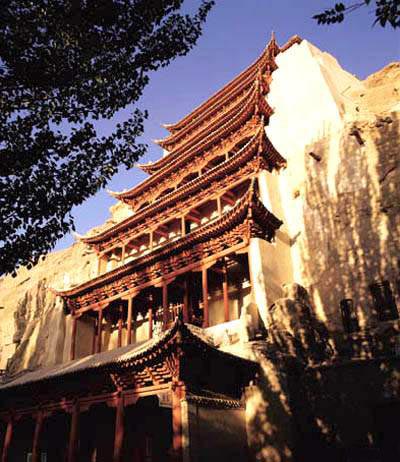|
Mogao Grottoes in Dunhuang
 The Grottoes of Dunhuang include the Mogao Grottoes, West Thousand-Buddha Cave and Yulin Grottoes. The grottoes are about 25 kilometers southeast of Dunhuang in Gansu Province and are hewn from a steep cliff at the foot of Mingsha Mountain. The Grottoes of Dunhuang include the Mogao Grottoes, West Thousand-Buddha Cave and Yulin Grottoes. The grottoes are about 25 kilometers southeast of Dunhuang in Gansu Province and are hewn from a steep cliff at the foot of Mingsha Mountain.
In places they are five stories high and their length from north to south is more than 1,600 meters. Work on the grottoes began in 366, the second year of the reign of Jianyuan of the pre-Qin Dynasty. In total there are 492 caves dating back to 16 dynasties including 16 Kingdoms, Northern Wei, Western Wei, Northern Zhou, Sui, Tang, Five Dynasties, Song, Xixia and Yuan. In the caves there are 45,000 square meters of murals, 2,415 color sculptures and some 4,000 celestial figures. In addition there are five timber buildings from the Tang and Song dynasties and 50,000 documents and cultural relics. The grottoes are a treasury of arts including architecture, painting and sculpture as well a treasure house of documents and cultural relics. They were listed as one of the world's cultural heritages in 1987.
Murals from various periods reflect social life, clothing, production, ancient architecture, music, dance and acrobatics and are a historical record of cultural exchanges between China and other regions. The images in the grottoes are a valuable reference for the study of ancient Chinese society from the fourth century to the 14th century.
The murals of the Mogao Grottoes are of high historical and artistic value. Those from the Tang Dynasty achieve the highest artistic perfection with strong figures that are well shaped and proportioned and featuring attractive lively images.
The painted statues in the Dunhuang Grottoes focus on integration of color and form leaving space for color and lines to supplement each other. Bright colors exaggerate the characteristics of the subjects.
The most impressive caves are Cave 96, 17, 130, 158, 259, 285, 200 and 428.
Included in the UNESCO world heritage list in 1987.
Source: http://old.cnta.gov.cn
|